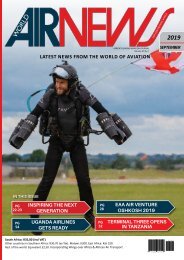World AirNews June 2018
- No tags were found...
Create successful ePaper yourself
Turn your PDF publications into a flip-book with our unique Google optimized e-Paper software.
ILA BERLIN<br />
FUTURE COMBAT<br />
AIR SYSTEM<br />
A<br />
IRBUS AND Dassault Aviation have decided to join forces<br />
for the development and production of Europe’s Future<br />
Combat Air System (FCAS), which is slated to complement and<br />
eventually replace current generation of Eurofighter and Rafale<br />
fighter aircraft between 2035 and 2040.<br />
The partnership, sealed in Berlin by Dirk Hoke, Airbus Defence<br />
and Space Chief Executive Officer (CEO) and Eric Trappier, Chairman<br />
and CEO of Dassault Aviation, represents a landmark industrial<br />
agreement to secure European sovereignty and technological<br />
leadership in the military aviation sector for the coming decades.<br />
“Never before has Europe been more determined to safeguard<br />
and foster its political and industrial autonomy and sovereignty in<br />
the defence sector. Airbus and Dassault Aviation have absolutely<br />
the right expertise to lead the FCAS project.<br />
Both companies are already co-operating successfully on Europe’s<br />
medium altitude long endurance new generation drone programme,”<br />
said Dirk Hoke, CEO of Airbus Defence and Space. “FCAS<br />
takes this successful cooperation to the next level and we are<br />
absolutely committed to tackling this challenging mission together<br />
with Dassault Aviation.<br />
“The schedule is tight, so we need to start working together<br />
immediately by defining a joint roadmap on how best to meet<br />
the requirements and timelines to be set by the two nations. It is<br />
therefore of key importance that France and Germany launch an<br />
initial joint study this year to address this task.”<br />
Eric Trappier, Chairman and CEO of Dassault Aviation, said: “We<br />
are convinced that by deploying our joint expertise, Dassault<br />
Aviation and Airbus can best meet the operational requirements of<br />
the Forces in the development of this critically important European<br />
programme. Both companies fully intend to work together in<br />
the most pragmatic and efficient manner. Our joint roadmap will<br />
include proposals to develop demonstrators for the FCAS programme<br />
as of 2025.<br />
“I am convinced that European sovereignty and strategic autonomy<br />
can, and will, only be ensured through independent European<br />
solutions. The vision that France and Germany have set forth with<br />
FCAS is a bold one and it’s an important signal in, and for, Europe.<br />
DASSAULT RAFALE<br />
Landmark industrial agreement to secure European sovereignty<br />
<strong>World</strong> Airnews | <strong>June</strong> <strong>2018</strong><br />
— 42 —<br />
The FCAS programme will strengthen the political and military ties<br />
between Europe’s core nations and it will reinvigorate its aerospace<br />
industry.”<br />
Airbus Defence and Space and Dassault Aviation agree on the importance<br />
of efficient industrial governance in military programmes.<br />
This also includes the involvement of other key European defence<br />
industrial players and nations based on government funding<br />
and on the principle of best contribution.<br />
Overall, FCAS defines a system of systems combining a wide<br />
range of elements connected and operating together, including<br />
a next generation fighter aircraft together with Medium-Altitude<br />
Long-Endurance Unmanned Aerial Vehicles (UAVs), the existing<br />
fleet of aircraft (which will still operate beyond 2040), future cruise<br />
missiles and drones flying in swarms.<br />
The overall system will be interoperable and connected in a<br />
larger perimeter with mission aircraft, satellites, NATO systems and<br />
land and naval combat systems. Q<br />
Airbus Defence AnD spAce chief executive<br />
Officer (ceO) Dirk HOke seals tHe Deal witH<br />
Dassault aviatiOn cHairman<br />
AnD ceO eric trAppier<br />
AIRBUS EUROFIGHTER<br />
ILA BERLIN<br />
A<br />
IRBUS, WHICH showcased<br />
its “Flight Lab”<br />
BLADE demonstrator aircraft<br />
for the first time at a major<br />
air show, has signed an accord<br />
with numerous stakeholders to<br />
mark the joint success of bringing<br />
this unique programme<br />
to fruition, but also to affirm<br />
their desire to build on this<br />
programme in the European<br />
framework of Clean Sky.<br />
The stakeholders along with<br />
Airbus CEO, Tom Enders, at the<br />
ceremony during the recent<br />
ILA Berlin Air Show, included<br />
members of the European<br />
Parliament, the European Commission,<br />
the German Government,<br />
European Member States<br />
and industrial partners across<br />
Europe.<br />
The BLADE project, which<br />
stands for “Breakthrough<br />
Laminar Aircraft Demonstrator<br />
in Europe”, is part of the first<br />
phase of Clean Sky – a 1, 6-billion<br />
Euro programme which has<br />
been running since 2008.<br />
BLADE has been tasked with<br />
ILA BERLIN<br />
assessing the feasibility of<br />
introducing laminar flow wing<br />
technology on a large airliner.<br />
It aims to improve aviation’s<br />
ecological footprint, bringing<br />
with it a 10 percent aircraft<br />
drag reduction and up to five<br />
percent lower CO2 emissions.<br />
Airbus worked with a team of<br />
more than 20 key partners and<br />
around 500 contributors from<br />
all over Europe. Moreover,<br />
due to its size and complexity,<br />
this project was only possible<br />
O<br />
N THE eve of the ILA Berlin Air Show <strong>2018</strong>, Airbus and<br />
Eurofighter GmbH submitted their offer to the German<br />
Ministry of Defence for a replacement of the Bundeswehr’s ageing<br />
Tornado combat aircraft, developed in the 1960s, with the Eurofighter<br />
as its ideal successor.<br />
Currently, the German Air Force is planning to phase out the<br />
Tornado from 2025 onwards and to transfer capabilities to another<br />
weapon system. As the Eurofighter system is already in use by<br />
Germany, this system could seamlessly adopt the capabilities of<br />
the Tornado aircraft. In addition, increased use of the same type<br />
of aircraft would result in considerable cost savings in terms of support<br />
services and training costs due to economies of scale, which<br />
would also reduce per-hour flying costs within the German Armed<br />
Forces.<br />
“The Eurofighter is already the backbone of the German Air<br />
presenting . . .<br />
‘Flight lab’ blaDe<br />
test aircraFt<br />
<strong>World</strong> Airnews | <strong>June</strong> <strong>2018</strong><br />
— 43 —<br />
thanks to the European Research<br />
initiative Clean Sky.<br />
In September 2017 Airbus’<br />
A340 laminar-flow Flight Lab<br />
test demonstrator aircraft<br />
(A340-300) made its successful<br />
maiden flight and since then<br />
has been engaged in successful<br />
testing to explore the wing’s<br />
characteristics in flight.<br />
The test aircraft is the first<br />
in the world to combine a<br />
transonic laminar wing profile<br />
with a true internal primary<br />
structure.<br />
On the outside the aircraft is<br />
fitted with two representative<br />
transonic laminar outer-wings,<br />
while inside the cabin there<br />
is a highly complex specialist<br />
flight-test-instrumentation (FTI)<br />
station.<br />
The extensive modifications<br />
to the A340-300 test-bed<br />
aircraft took place during the<br />
course of a 16-month working<br />
party in Tarbes, France, with<br />
the support of the numerous<br />
industrial partners across<br />
Europe.<br />
In terms of the testing technology,<br />
notable ‘firsts’ included<br />
the use of infrared cameras to<br />
monitor the laminar flow transition<br />
points and the acoustic<br />
generator which measures<br />
the influence of acoustics on<br />
laminarity.<br />
Another first is the innovative<br />
reflectometry system which<br />
measures overall deformation<br />
in real-time during flight.<br />
To date the Flight Lab has performed<br />
66 flight hours. Flights<br />
will continue until 2019, dedicated<br />
to exploring the influencing<br />
factors on laminarity. Q<br />
teaM eUrOFighter presents OFFer tO<br />
gerManY<br />
Force and is therefore the logical option to adopt the capabilities<br />
of the Tornado in the medium term,” said Bernhard Brenner,<br />
Head of Marketing and Sales at Airbus Defence and Space. “We<br />
have an excellent aircraft; its production secures important aircraft<br />
construction know-how in Germany and, at the same time,<br />
strongly supports European sovereignty in defence. The successful<br />
continuation of Eurofighter production could also lead to further<br />
co-operation with other European nations such as Switzerland,<br />
Belgium and Finland.”<br />
Volker Paltzo, Eurofighter Jagdflugzeug GmbH CEO, said: “I am<br />
confident that Eurofighter Typhoon can provide a cost effective<br />
and attractive solution for Germany, which will deliver every capability<br />
and perform every mission the German Air Force needs.”<br />
In the medium term, the further development of the Eurofighter<br />
will provide the technological basis for the next generation of<br />
European combat aircraft. The intent of collaboration was agreed<br />
between France and Germany in July 2017. The aircraft are currently<br />
expected to enter into service around 2040. Q





